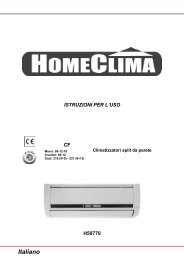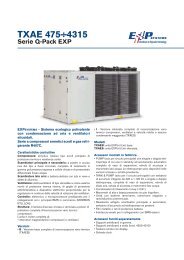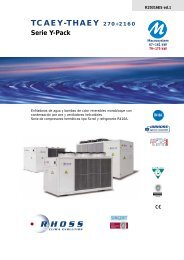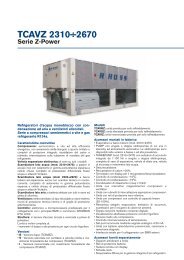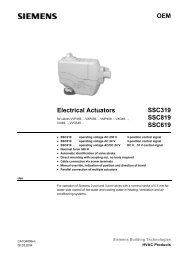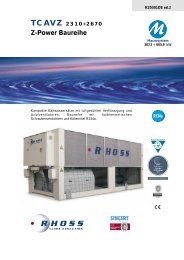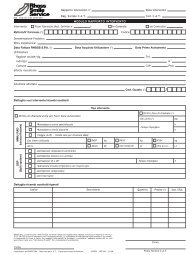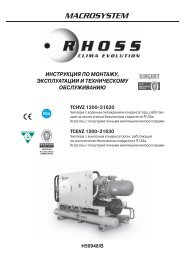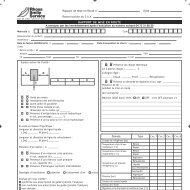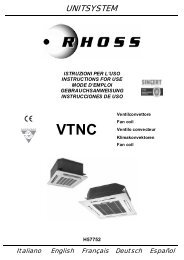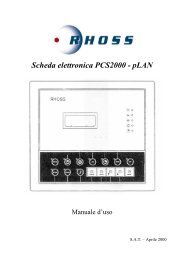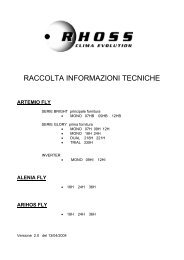SPLIT-SYSTEM - Rhoss
SPLIT-SYSTEM - Rhoss
SPLIT-SYSTEM - Rhoss
You also want an ePaper? Increase the reach of your titles
YUMPU automatically turns print PDFs into web optimized ePapers that Google loves.
SECTION I: USER<br />
I.11 ORDINARY MAINTENANCE TO BE<br />
PERFORMED BY USER<br />
DANGER!<br />
Always turn off the automatic main switch (IG) for<br />
the protection of the entire system before doing any<br />
maintenance work, even if it is only an inspection.<br />
Make sure that no one accidentally supplies power<br />
to the machine – lock the automatic main switch in<br />
the off position.<br />
I.11.1<br />
CLEANING THE INTERNAL UNIT<br />
Use a soft, dry cloth to clean the unit. A cloth dampened with a little cold<br />
water can be used if the unit is very dirty (make sure you do not use<br />
very wet cloths).<br />
Do not spray water on the air conditioning unit surfaces.<br />
Do not use chemical products, solvents or similar liquids for cleaning<br />
the surfaces of the air conditioning unit.<br />
Do not spray insecticides or spray deodorants directly onto the air<br />
conditioning unit.<br />
I.11.2<br />
CLEANING THE EXTERNAL UNIT<br />
The external unit does not normally require any particular cleaning<br />
operations. If it is installed in dusty or polluted zones, the external heat<br />
exchanger should be cleaned from time to time. In any case, this<br />
operation should be performed by qualified personnel.<br />
At the start of the season, before starting up the unit, check that there<br />
are no blockages in the external unit inlet and outlet air flow.<br />
At the end of season, if the unit is to be out of use for long periods of<br />
time after operating in cooling mode, we recommend running it for a few<br />
hours in fan mode FAN before switching it off definitively, in order to<br />
make any condensation in the internal unit evaporate.<br />
I.11.3<br />
CLEANING THE AIR FILTER<br />
I.11.4<br />
CLEANING THE REMOTE CONTROL<br />
Use a soft, dry cloth only when cleaning the remote control.<br />
I.12 WARNING AND SUGGESTIONS<br />
The unit must not operate continuously in cooling mode in rooms with a<br />
high relative humidity (above 80%). In these conditions condensation<br />
could form on the mouth of the air outlet which could damage objects<br />
below it, or the floor, or the wall to which the unit is attached.<br />
Always avoid obstructing the flow of air, or using the unit as a surface to<br />
lean on.<br />
DANGER!<br />
Take care when dismantling the filter: the heat<br />
exchanger fins can cut.<br />
IMPORTANT!<br />
Always have the filters installed when running the<br />
unit.<br />
To ensure correct air intake, the air filter must be cleaned at least once<br />
a month, or more frequently if the unit is being used in very dusty<br />
environments. Regular cleaning will make the unit run more efficiently.<br />
In order to extract the air filter, raise the suction panel, pull the central<br />
unit flap downwards and slip it out. Clean the filter with a vacuum<br />
cleaner and wash it with cold water if necessary, drying it in the shade.<br />
When the filter is clean and dry, replace it by proceeding in reverse<br />
order. If the filter is damaged, it must be replaced with an original<br />
RHOSS filter.<br />
The use of water or aerosol sprays in proximity to the unit can cause<br />
electric shocks and malfunctions.<br />
28



